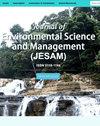历史文化名镇声景观时空特征研究——以夏河县拉卜郎镇为例
IF 0.3
4区 环境科学与生态学
Q4 ENVIRONMENTAL SCIENCES
引用次数: 0
摘要
本研究基于对拉卜朗镇声学目标数据的实地测量,绘制了一张声级图,并从时空的角度描绘了声景特征。拉卜朗老城区的声级分布不平衡。空间特征表明,东部地区的声级高于西部地区;核心区域,高于边缘区域;结节区高于均质区。在典型的“塔瓦”社区和寺庙区域,声音水平较低,交通沿线区域和“结节区”的声音水平较高。声景的空间分布与城市功能区和人群行为活动密切相关。时间特征具有明显的波动性和特殊性。声音水平的变化和音景的特征与僧侣和居民的生活节奏有关。从历史文化名城声环境保护的角度出发,要优化城市功能结构,加强声环境管理,就必须重视声景观的建设。本文章由计算机程序翻译,如有差异,请以英文原文为准。
Study on the Spatio-temporal Characteristics of Soundscape in Famous Historical and Cultural Towns: a Case Study of Labrang Town, Xiahe County, China
This study based on field measurements of the acoustic objective data of Labrang town, draws a sound level map and depicts the soundscape characteristics from the perspective of space-time. The distribution of sound levels is imbalanced in the old urban area of Labrang town. The spatial characteristics show that the eastern region has higher sound levels than does the western region; the core area, higher than the edge area; and the nodular area, higher than the homogeneous area. In the typical “Tawa” community and temple area, the sound level is low, and there is a high level of sound in the area along the traffic line and the “nodule area”. The spatial distribution of the soundscapes is closely related to the urban functional area and crowd behaviour activities. The time characteristic has an obvious fluctuation and particularity. The changes in sound levels and the characteristic of soundscapes are related to the life rhythms of monks and residents. From the point of view of sound protection in historic and cultural cities, it is necessary to pay attention to the construction of soundscapes in order to optimize the urban functional structure and strengthen the management of the sound environment.
求助全文
通过发布文献求助,成功后即可免费获取论文全文。
去求助
来源期刊

Journal of Environmental Science and Management
ENVIRONMENTAL SCIENCES-
CiteScore
0.90
自引率
0.00%
发文量
10
审稿时长
2 months
期刊介绍:
The Journal of Environmental Science and Management (JESAM) is an international scientific journal produced semi-annually by the University of the Philippines Los Baños (UPLB).
JESAM gives particular premium to manuscript submissions that employ integrated methods resulting to analyses that provide new insights in environmental science, particularly in the areas of:
environmental planning and management;
protected areas development, planning, and management;
community-based resources management;
environmental chemistry and toxicology;
environmental restoration;
social theory and environment; and
environmental security and management.
 求助内容:
求助内容: 应助结果提醒方式:
应助结果提醒方式:


